While I wrote about the more famous Angkor Wat visit earlier in
part one of this series, this post is about a series of temples & monuments that we visited after seeing the majestic sunrise at Angkor Wat. Angkor Thom, which in Khmer means "Royal City" is a group of temples and monuments, close to Angkor Wat.
Bayon - The Temple of a Thousand Faces
Bayon is instantly recognizable by the multitude of serene and benevolent faces carved on it's towers.
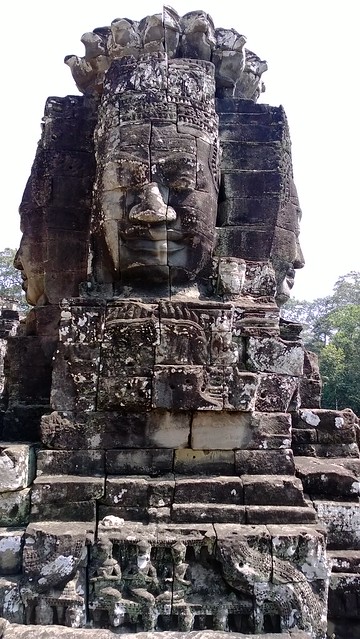 |
| Bayon |
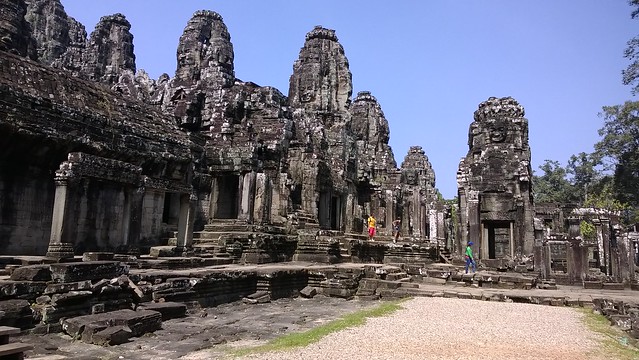 |
| Another view of Bayon |
These faces are numerous around the temple, and some authors and historians refer to this as the "Temple of a Thousand Faces". The real number of faces could be closer to a few hundred though, by my reckoning, but that does not make it less impressive. Each of these depict a set of four faces, oriented facing the four cardinal directions. Each face has a benevolent and compassionate smile. It could be that these faces represent Brahma, but it was mentioned by our guide that these represented the king who sanctioned the building of this temple (
Jayavarman VII).
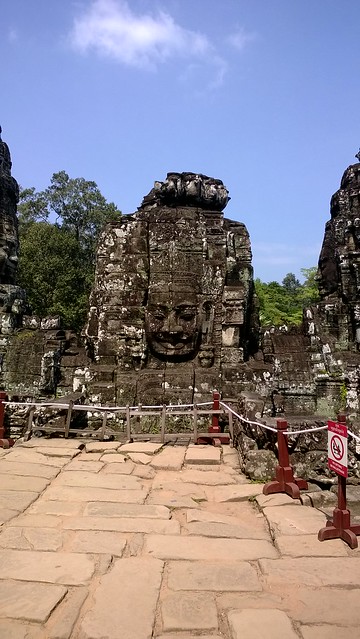 |
| Another view of the face of Jayavarman II. |
One of the interesting features of Bayon is that there are carvings on the wall surrounding the temple, depicting Cambodian life in the twelft century. Some walls show interesting scenes from battles against the Cham (a Vietnamese kingdom).
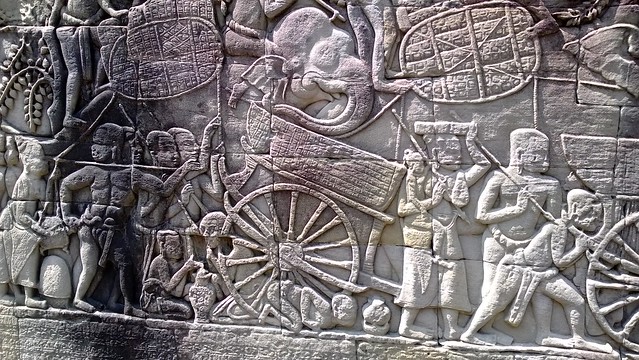 |
| Note the guy cooking - Bending over a pot to blow on the fire. |
|
Looking closely at the battle scenes, you can see the difference in the depiction of Khmer soldiers and Chinese mercenaries who fought for the Khmer king. The Chinese are identified by the presence of a top knot in their hair. The Khmer soldiers are behind the horseman, and have distinctly different facial features.
This is just one of the things that you would have a hard time noticing without a guide (we had negotiated for one near the Angkor Wat entrance).
 |
| Chinese to the right, Khmer solders to the left (behind the horse). |
Other parts of the wall depict naval battles between the Khmers and the Chams, with equally interesting carvings. Note the crocodile in the picture below!
 |
| Naval battle between Khmers and Chams |
The carvings on the walls outside depict the daily life and battles of the Khmer kingdom, while inside the temple, you have more carvings of apsaras or "devatas" as they as called.

Bayon was definitely one of the highs of our Cambodia trip. The temple quite mesmerizes you.The view as you leave the temple looks like two hands held together in prayer. A nice touch in the architecture!

Bauphon
After Bayon, our guide took us to another temple called Bauphon. This temple does not look very impressive today, because of the state of dis-repair it is in. However, it was a large and important temple, pre-dating Angkor Wat and Bayon. The temple was being restored by French archeologists, when the civil war in Cambodia forced them to abandon their efforts.Today Bauphon temple looks similar to an Aztec pyramid.
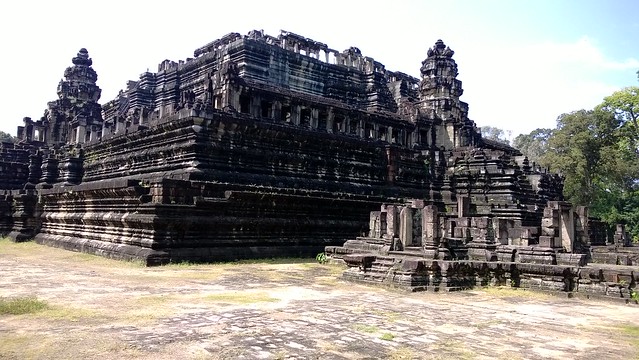 |
| Bauphon temple |
Bauphon was a Shiva temple, and was built on the same "mountain-temple' blueprint of Angkor Wat (i.e. the central towers of the temple depict Mount Meru). A short walk around Bauphon are other smaller sites, like the "Terrace of Elephants" and "Terrace of the Leper King".
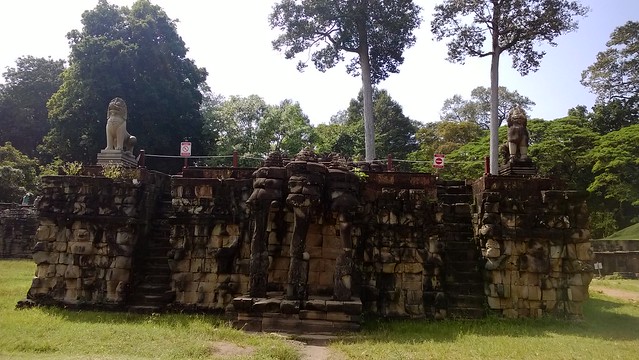 |
| Terrace of Elephants |
After visiting these places, our guide took us to a nice little restaurant for lunch. Throughout the trip, we did not get enough time to explore Cambodian cuisine, but this was one of the times that we had a taste of the local fare.After a good lunch, we headed off to the last site for the day - Ta Phrom.
Ta Phrom - The Ancestor of Bramha
Ta Phrom is instantly recognizable by all Lara Croft/Angelina Jolie fans.The guides here always mention that the Tomb Raider movie (one of them, at least) was shot here. Once you see the temple, you realize why it is any Hollywood adventure-genre producer's dream come true. Ta Phrom is half temple, half nature. The trees have intertwined themselves with the temple structures to form a strange amalgamation that is unique and awe-inspiring.
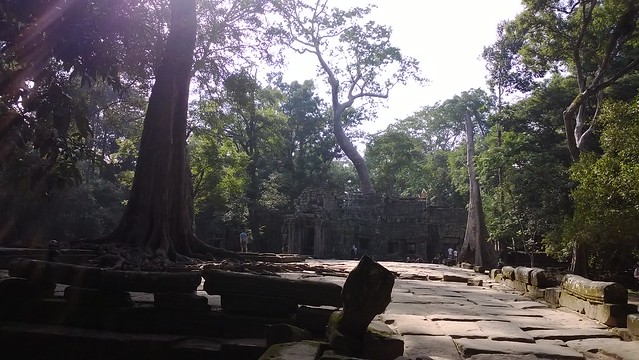 |
| As you walk down the entrance, the first view of the temple. |
 |
| Ta Phrom - temple and trees are one. |
I felt like an adventurer-explorer myself when walking through these ruins! One can easily imagine the wonder that the first French explorers felt on seeing this site, lost in the jungle. The entire temple complex has been embraced by the stout roots of these jungle trees, as if mother nature was actually guarding the temple.
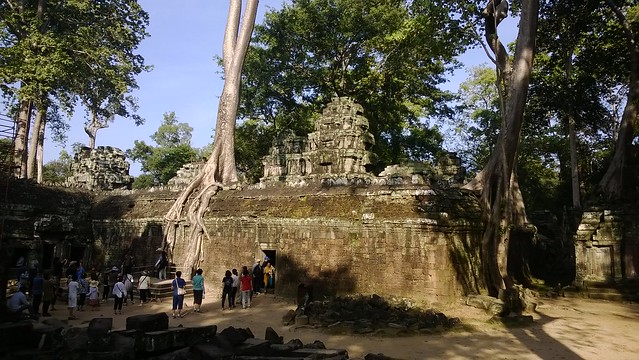 |
| Ta Phrom |
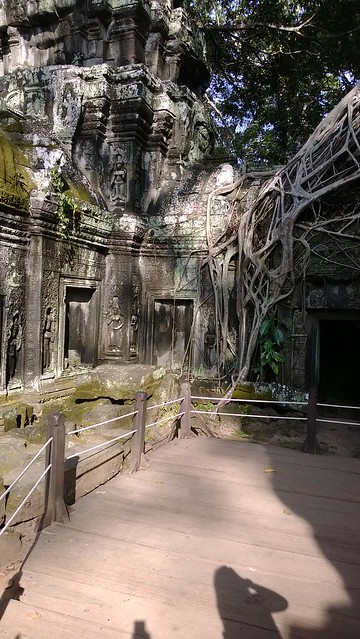 |
| More roots mangled with the temple |
Our guide explained that "Ta Phrom" means the ancestor of Bramha (Bramha being the creator in the Hindu holy trinity). However the place was actually a Buddhist temple, and not a Hindu one. It was also known as "Raj-Vihara", which literally means "royal monastery". There is a Dancing Hall present here, where a heavy gold headdress has been discovered. If you are confused why a monastery needs a "dancing hall", well remember that we cannot judge 12 century norms with 21st century sensibilities.
Interesting note - Indian tourists would be proud to know that Ta Phrom has been restored by the Archealogical Survey of India.
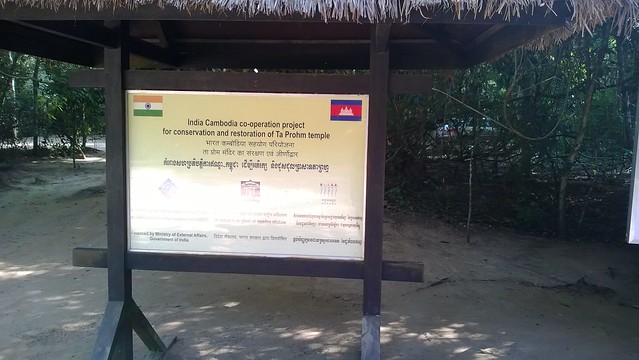 |
| We are so proud of you, ASI! |
In true ASI-style, they have boards all over the place warning us if a place is dangerous, or if we should not stand too close to something. Very thoughtfully, the warning signs are tri-lingual, with English, Khmer, and Hindi. So the odd 2 or 3 Indian tourists here who cannot read English signs will still be able to understand ASI's warnings!















No comments:
Post a Comment